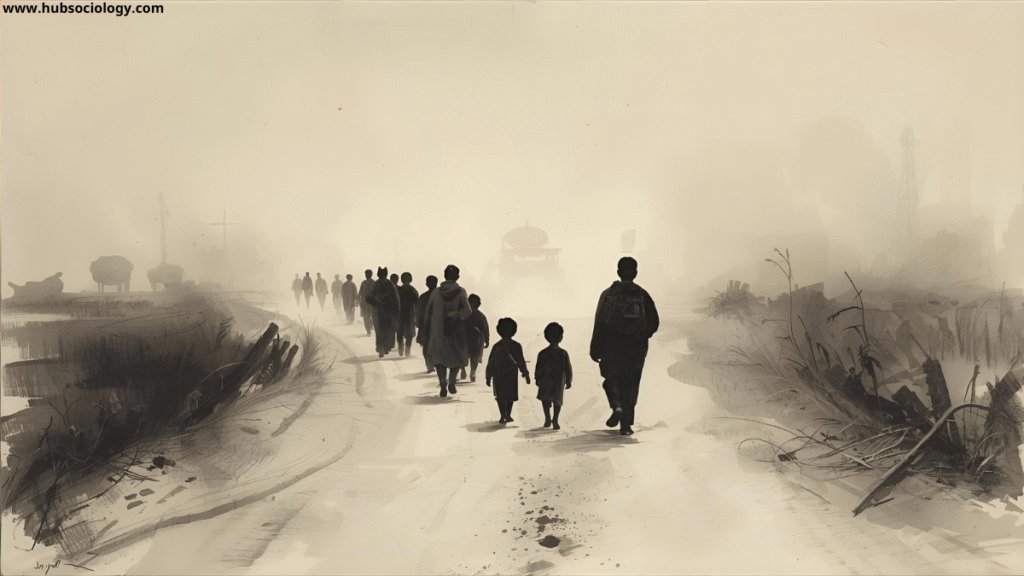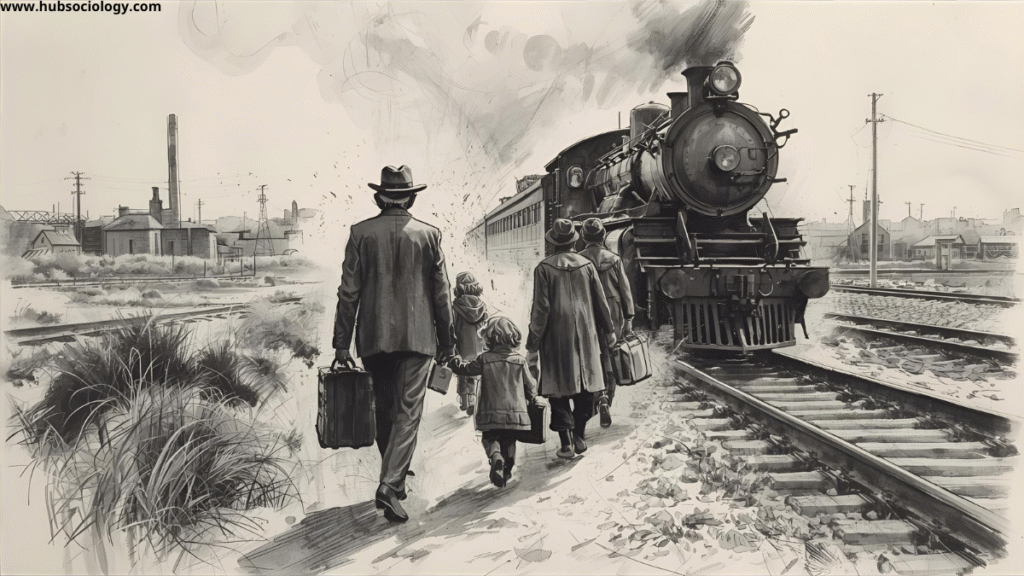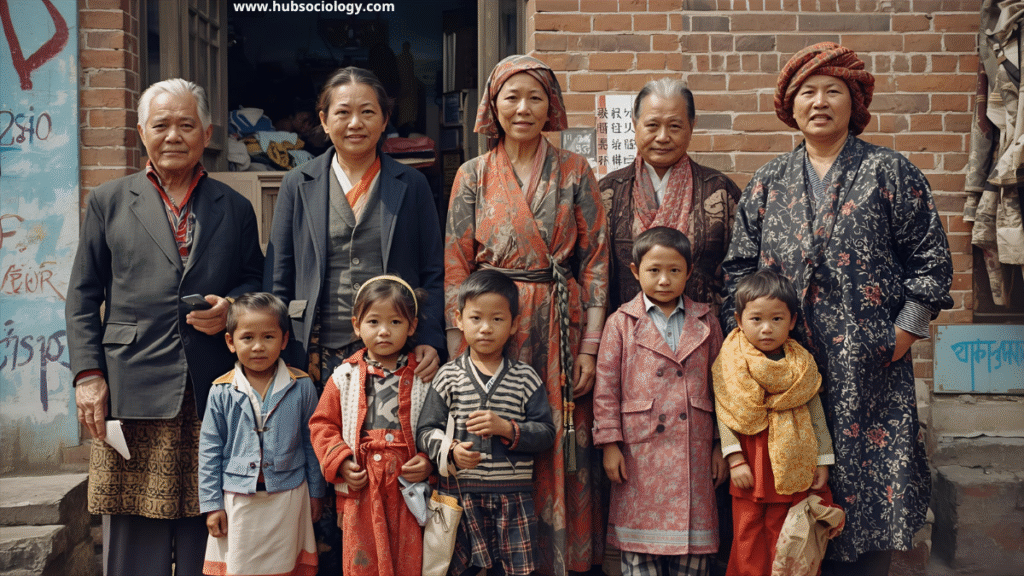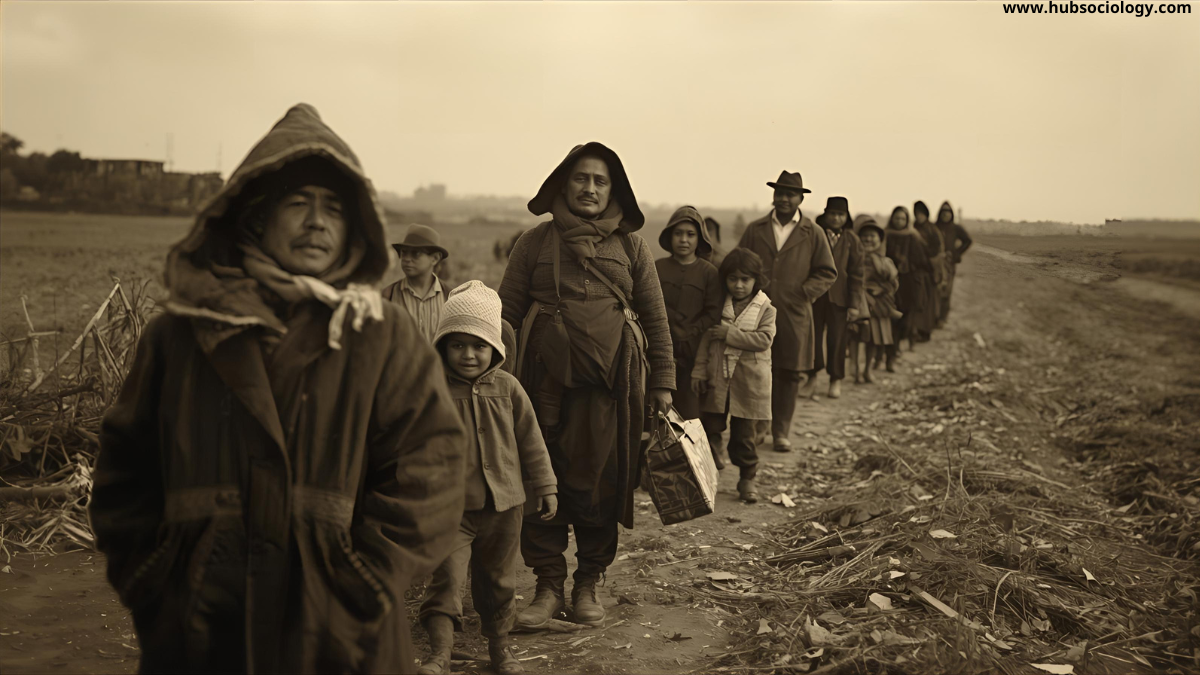Introduction on Migration during Colonial Period
Migration has been a defining feature of human history, but the colonial period introduced new dimensions and complexities to the movement of people across regions and continents. Between the 16th and mid-20th centuries, colonialism reshaped global demography, economy, and social structures through forced, voluntary, and semi-voluntary migrations. The colonial states not only expanded their political control but also reorganized societies through systems of labor exploitation, trade networks, and cultural domination.
Examining migration during colonial period from a sociological perspective provides insights into how power relations, class structures, and cultural exchanges were formed under conditions of inequality and coercion.

Table of Contents
Migration and Colonial Expansion
Colonial powers such as Britain, France, Spain, Portugal, and the Netherlands extended their control over Asia, Africa, and the Americas to secure resources, trade, and strategic advantage. Migration was central to this process. Unlike earlier migrations driven by subsistence or kinship ties, colonial migrations were often structured and regulated by states and corporations. These flows were not neutral but shaped by the asymmetry of power between colonizers and colonized populations. Migration under colonialism created hierarchies that reinforced economic dependency and cultural subjugation.
Categories of Migration during Colonial Period
1. Forced Migration
The transatlantic slave trade represents the most brutal form of migration during the colonial era. Between the 16th and 19th centuries, millions of Africans were forcibly transported to the Americas to work on plantations. Enslaved people were treated as commodities, and their displacement severed social bonds, destroyed communities, and created long-lasting trauma. From a sociological perspective, this demonstrates how migration can become a mechanism of domination, where human mobility is stripped of agency and turned into an instrument of exploitation.
2. Indentured Labor Migration
When slavery was formally abolished in the 19th century, colonial powers replaced it with indentured labor systems. Indians, Chinese, and other colonized populations were recruited through contracts—often deceptive—to work on plantations, railways, and mines in colonies such as the Caribbean, Mauritius, Fiji, South Africa, and Southeast Asia. Although technically not enslaved, these workers faced poor conditions, racial discrimination, and restrictions on mobility. This migration reveals the colonial strategy of maintaining cheap labor supplies through legal and economic coercion.
3. Voluntary Migration
Not all migration under colonialism was forced. Some groups voluntarily migrated within and across colonies for trade, education, or better opportunities. For example, skilled artisans, clerks, and professionals from colonized societies moved to administrative centers to serve colonial bureaucracies. Missionaries and students also traveled abroad, creating early global networks of cultural and intellectual exchange. Yet, even these “voluntary” migrations were shaped by colonial hierarchies, as opportunities were unevenly distributed.
4. Colonizer Migration
Another major flow was the migration of Europeans to colonies. Settler colonies such as Canada, Australia, New Zealand, and parts of Africa witnessed significant European migration. These settlers often displaced indigenous populations, creating societies where power and landownership were racially structured. In contrast, in non-settler colonies like India, European migrants served administrative, military, and commercial roles, maintaining social distance from the local populations.
Sociological Dimensions of Migration during Colonial Period

1. Labor and Class Structures
Colonial migration flows reorganized labor markets and created new class divisions. Enslaved Africans and indentured Indians formed the backbone of plantation economies, while colonizers occupied elite administrative and commercial positions. Migration, therefore, did not simply redistribute populations but established stratified systems of labor that were racialized and hierarchical. This shaped modern global inequalities, where wealth accumulated in colonial metropoles at the expense of colonized labor.
2. Cultural Hybridization and Identity Formation
Migration under colonialism led to cultural exchanges, but these were often asymmetrical. In plantation societies, African, Indian, and European cultures blended, giving rise to hybrid identities such as Afro-Caribbean and Indo-Caribbean communities. At the same time, colonial migration reinforced racial categorizations, where migrants were labeled, segregated, and stereotyped. Sociologically, this highlights the dialectic of identity—how migration creates new cultural forms while also reinforcing boundaries.
3. Gender and Family Structures
Colonial migration was often gender-skewed. Slave and indentured labor migrations were dominated by men, leading to disruptions in family structures. Women who migrated faced dual exploitation—both as workers and as subjects of patriarchal control within colonial systems. For example, in Indian indenture migration, women were often outnumbered and vulnerable to exploitation by overseers and male workers. These imbalances had long-term effects on kinship systems and community organization in migrant societies.
4. Resistance and Agency
Although colonial migrations were structured by coercion, migrants exercised forms of resistance and agency. Enslaved people resisted through revolts, escape, and cultural retention. Indentured laborers used petitions, strikes, and community solidarity to negotiate better conditions. Voluntary migrants formed diasporic associations, religious networks, and educational movements that challenged colonial domination. Migration thus became not only a site of oppression but also of resilience and resistance.
Regional Patterns of Migration during Colonial Period
1. Africa
The most devastating migration was the transatlantic slave trade, but Africa also experienced internal forced migrations due to colonial wars and labor recruitment for mines and infrastructure. European settlement in southern Africa created racial segregation that persisted into apartheid.
2. Asia
India was the largest source of indentured labor, with millions sent to colonies across the world. Chinese migrants also played a major role in Southeast Asia and the Americas. These migrations reshaped ethnic compositions in many regions, creating plural societies with complex intergroup relations.
3. The Americas
Colonial migration turned the Americas into a melting pot of African, European, and indigenous populations. Plantation economies relied on African slaves and later indentured Indians and Chinese. European settlers dominated land and political power, producing deeply stratified societies.
4. Pacific and Oceania
In Fiji, Mauritius, and other islands, Indian indentured workers transformed local demographics. European settlers in Australia and New Zealand displaced indigenous peoples, while Asian migrants contributed to the labor force.
Long-Term Sociological Impacts
The legacies of colonial migration continue to shape contemporary societies. Racial inequalities, diasporic identities, and cultural hybridity trace back to colonial-era population movements. Diaspora communities created through indenture and slavery maintain cultural links with their homelands while also forging new identities in host societies. At the same time, the structural inequalities of colonial labor systems contributed to global north-south disparities in wealth and power.
From a sociological lens, colonial migration flows illustrate how human mobility is deeply embedded in structures of power. Migration was not merely about economic necessity but also about domination, control, and resistance. Understanding these historical migrations helps explain modern issues of race, ethnicity, and globalization.
Conclusion on Migration during Colonial Period

Migration during the colonial period was a complex and multilayered phenomenon that involved forced displacement, economic coercion, and voluntary movement. It redefined labor relations, reshaped cultural identities, and produced new social hierarchies. While colonial migration flows often emerged from exploitation and inequality, they also fostered resilience, hybridity, and diasporic solidarity. A sociological understanding of colonial migration highlights the intersection of power, culture, and social structure, reminding us that the movement of people is not only a demographic fact but also a deeply social and political process.
Do you like this this Article ? You Can follow as on :-
Facebook – https://www.facebook.com/hubsociology
Whatsapp Channel – https://whatsapp.com/channel/0029Vb6D8vGKWEKpJpu5QP0O
Gmail – hubsociology@gmail.com
Topic-related questions on Migration during Colonial Period
5 Marks Questions on Migration during Colonial Period
- Define forced migration during the colonial period with an example.
- What was the indentured labor system, and why did it emerge?
- Mention two regions where Indian indentured workers were sent under colonial rule.
- State one sociological impact of European settler migration.
- How did colonial migration affect gender balance in labor flows?
10 Marks Questions on Migration during Colonial Period
- Discuss the role of migration in the making of colonial labor and class structures.
- Explain how cultural hybridization emerged due to colonial migration.
- Compare forced and voluntary migration during the colonial period with suitable examples.
- Examine the sociological significance of African slave migration to the Americas.
- Analyze the role of resistance and agency among migrants under colonial labor systems.
15 Marks Questions on Migration during Colonial Period
- Critically examine the sociological dimensions of indentured labor migration from India during the colonial era.
- Discuss the global patterns of colonial migration and their long-term sociological impacts.
- “Colonial migration flows were shaped by coercion but also created new identities and communities.” Discuss.
- Evaluate the role of migration in restructuring societies in Africa, Asia, and the Americas during the colonial period.
- How did colonial migration flows reinforce global inequalities? Illustrate with sociological arguments.
